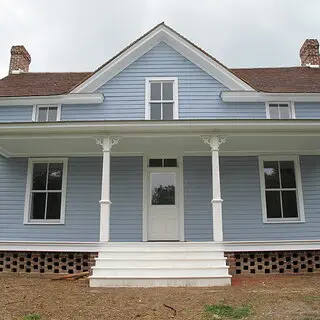
African American Cultural Heritage Action Fund
Pauli Murray House
The Pauli Murray House in Durham, North Carolina was the home of Pauli Murray (1910-1985), an African American member of the LGBTQ community, a Civil Rights and Women’s Rights activist, the author of work that Thurgood Marshall called the “Bible for Civil Rights law”, a lawyer, the first female African American Episcopal priest, and an Episcopal saint.
In her adult life she was a professional nomad, living in over fifty different places in her pursuit of education and employment. Murray’s formative years were her childhood years, living with her grandfather, grandmother and aunt at what is now called the Pauli Murray House.
Pauli Murray was an important and well-known figure in the significant social movements of the twentieth century, but her legacy has been forgotten. She should be restored to her rightful place in American history, with her work continuing as the greatest tribute to her.

photo by: Pauli Murray Center for History and Social Justice
Pauli Murray House prior to its August 2016 exterior restoration and a fresh coat of paint.

photo by: Schlesinger Library, Radcliffe Institute, Harvard University
Pauli Murray

photo by: Schlesinger Library, Radcliffe Institute, Harvard University
Pauli holds her book Proud Shoes.

photo by: Schlesinger Library, Radcliffe Institute, Harvard University
Pauli Murray in the early 1960s.
The Pauli Murray House is a small and simple house, but in such a modest home, a giant of a figure in American history was nurtured. The Pauli Murray house was built ca. 1898 by Murray’s grandfather, Robert Fitzgerald, who was a Union Civil War veteran. Murray was a descendant of both slaves and slave holders.
Her grandparents and aunt stressed the importance of education. Murray graduated from Hunter College, and then took a law degree at Howard Law School, having been denied admission to the University of North Carolina because of her race. She later applied to Harvard Law School’s Graduate Program, but admission was denied because of her gender. She achieved her Masters of Law degree from the University of California, Berkeley.
Her involvement and leadership with organizations working for social justice brought her into contact with such influential individuals as President Franklin Roosevelt, Eleanor Roosevelt (a long- time friend), Betty Freidan, and President John F. Kennedy, who appointed her to his President’s Commission on the Status of Women. She was a co-founder of the National Organization for Women (NOW), worked for the Fellowship of Reconciliation, the NAACP, and many other civil rights groups.
Her most important contribution to the law is her book, States’ Laws on Race and Color (1951) which Thurgood Marshall called the Bible of Civil Rights law.
“Pauli Murray was decades ahead of her time. We want to nurture the next generation of Pauli Murrays.”
Barbara Lau, The Pauli Murray Center for History and Social Justice
Campaign Goals
- Rehabilitate the Pauli Murray House as the Pauli Murray Center for History and Social Justice
- Raise public awareness of the significance of Pauli Murray and her work
Opportunity
Rehabilitate the Pauli Murray House as the headquarters of the Pauli Murray Center for History and Social Justice, carrying on Pauli Murray’s civil rights work.
Support our work to save places that matter.
DonateStay connected with us via email. Sign up today.
Related Stories
-
African American Cultural Heritage Action Fund 6 Iconic Sites that Celebrate Black LGBTQ+ History -
African American Cultural Heritage Action Fund Refusing Despair: Angela Thorpe Mason on Channeling Pauli Murray
Explore More Places
Join us in protecting and restoring places where significant African American history happened.
Learn More



